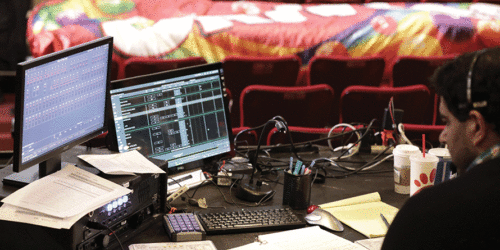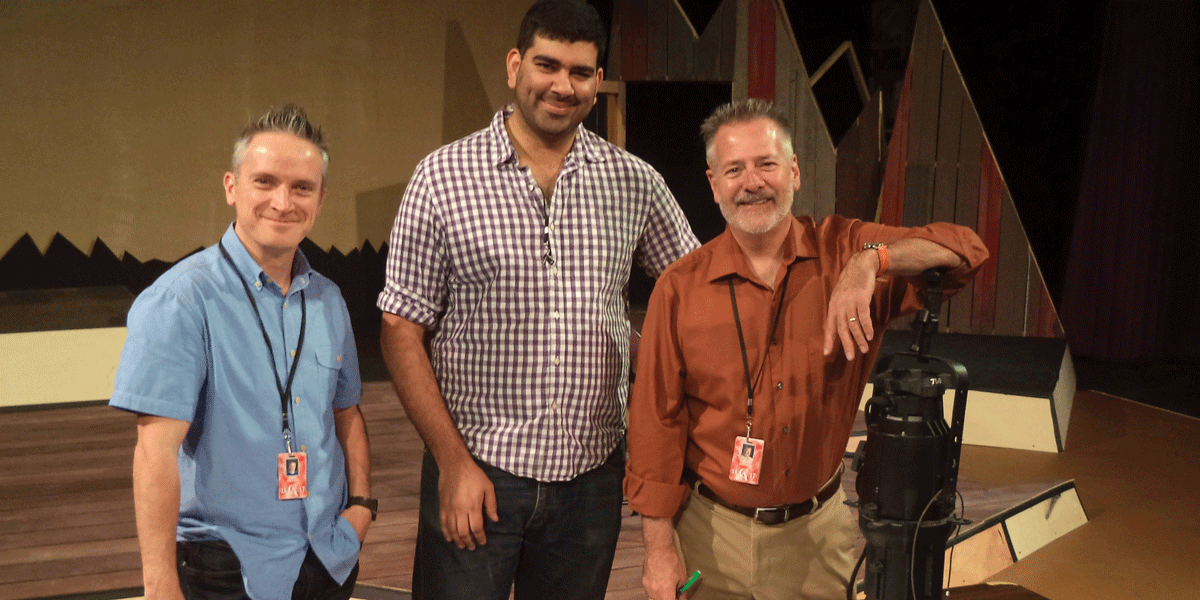It was Fall of 2000 when a young Anshu Bhatia ‘06 arrived at Colorado Academy in the Seventh Grade and discovered—somewhat to his dismay—that he would be required to take courses in the Arts Department.
“Choir was an option, but I did not see myself as a singer, so I had to find something else,” Bhatia says. “You can draw a super straight line from that Seventh Grade arts requirement to where I am today.”
Where is he today? On an ascendant international career path in scenic and lighting design for theater and opera. He spent much of his 2019 summer working with the Santa Fe Opera, considered one of the top summer opera festivals in the U.S., lighting its production of La Bohème. He is already booked for the fall of 2019, including an engagement lighting The Abduction from the Seraglio for the Lyric Opera of Kansas City.
And it all started when, reluctant to join a choir at CA, he chose to take Technical Theater instead.
“In hindsight, I can see that it was a perfect blend of my interest in computers and technology and my love for creative storytelling,” Bhatia says. “Technical Theater just spoke to me.”
Returning to his first love
Bhatia still remembers the first show he ran at CA. It was The Wizard of Oz. He had no interest in acting or directing—although he believes every lighting designer is a director—but, mentored by Steve Scherer, he loved taking rough lumber and transforming it into a finished set, a set that helped tell a story.
A self-described “nerd,” Technical Theater also spoke to his interest in computers and technology and his passion for finding the most modern solution to any problem.
But “like all good theater children,” he says, he assumed that his theater days were behind him when he left high school and started college. “I knew I was good at technical theater, but I didn’t think it was possible to make a living doing it,” he says. “I thought of it as a hobby.”
So, at the University of Denver, he began his Freshman year majoring in Pre-Law. Within six weeks, he dropped the program and came back to his first love—the theater.
Boot camp for design
With multiple AP classes under his belt, Bhatia raced through DU in three years. Along the way, he consumed every opportunity offered by the school’s smaller theater program, working on many different shows, learning from working theater professionals, and falling more deeply in love with the work. It was a time of “practice, lots of practice,” he says.

When he graduated from DU, he was accepted to New York University’s prestigious three-year master’s program in Design for Stage and Film, with an emphasis on scenic and lighting design. He credits “good recommendations, a good work ethic, and some luck.” Most of his fellow grad students had already worked in the industry and were several years older than he was. If DU had been a time to practice and experiment, NYU was a baptism in the real world.
“I didn’t know it was feasible for someone to work that hard,” he says, recalling many weeks that he pulled more than one all-nighter. “It was boot camp for design, and it was perfect.”
In his last year of graduate school, Bhatia met Mary Birnbaum, a young, up–and–coming talent, who has directed theater and opera productions around the world and is a faculty member at Juilliard. They have worked together on a number of productions, including the Santa Fe Bohème and Juilliard Opera’s Dido and Aeneas, which was performed in London and at the Palace of Versailles. They have, he says, a “dream collaboration” rooted in their joint commitment to collaborative storytelling from the beginning of the process to the final curtain.

The goal is for no one to notice
Based in New York, Bhatia has now achieved a level of success which allows him to be more selective about which projects he accepts. What he likes to do is join a creative team which may work together for up to two years before the actual production. “At the last possible minute, you reunite the initial idea with what’s happening on stage in a moment of coherent storytelling,” he says.
His approach to lighting his simple. “If people notice the lighting in a show, then you have done your job wrong,” he says. “The goal of lighting is for no one to notice.”
Bhatia remains close to Steve Scherer, his original CA mentor. He has returned to co-teach some classes with Scherer and praises him for his “exuberance for teaching the arts and for life.”
“You want to learn from him, because he is a special human being,” Bhatia says. “He really helped me learn this love of theater I have today.”
Bhatia also praises CA for allowing students to try everything. “You could play basketball and also design the high school musical,” he says. “CA never forced you to choose one passion over the other.” As for that arts requirement he faced nearly 20 years ago? “Every student should have to take art,” he says. “No matter where your future leads you, art is essential to your development as an individual.”
